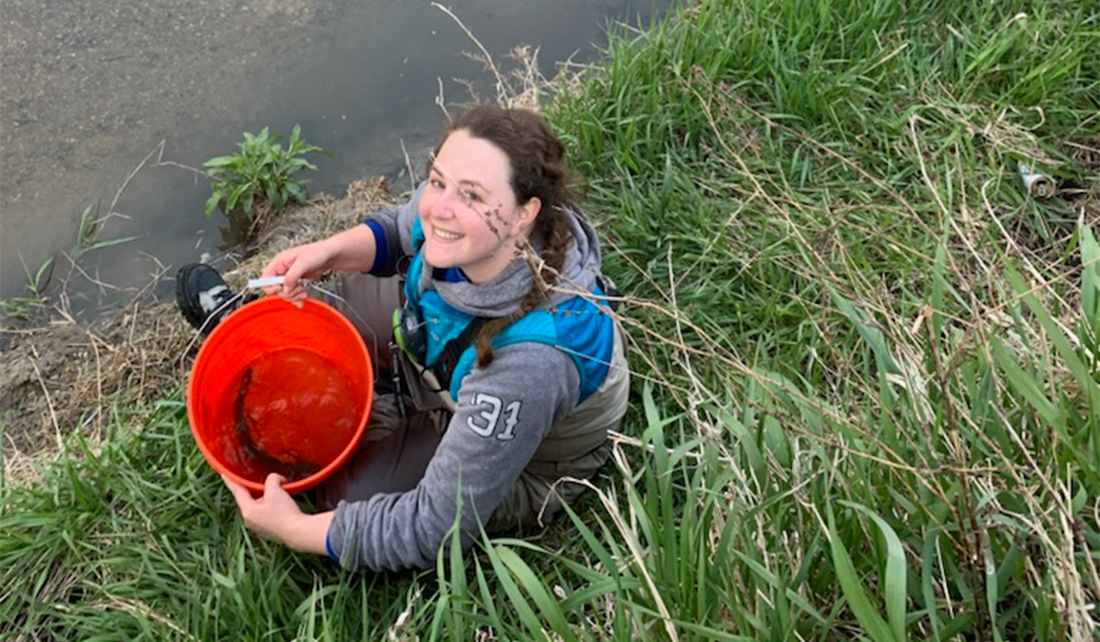
In this abbreviated interview, Research Coordinator Carolyn Foley and Communication Associate Sarah Gediman ask doctoral candidate Katey Strailey about her Illinois-Indiana Sea Grant-funded work. A researcher in the River and Landscape Systems Research Group at University of Illinois, Strailey is looking at how restoration structures in streams change turbulence, or flow of water, and what effects those changes have on fish.
When restoring streams, people may add physical structures as habitat to help fish, but relatively little is know about which structures are most beneficial. Doctoral candidate Katey Strailey is exploring this question using fish physiology, some really cool technology, and impressive surgical skills.
Q: Why did you choose to pursue this research?
A: Freshwater fish are some of the most endangered vertebrates on the planet. 40-50% of freshwater fish are endangered, and river fish have it particularly bad. Rivers are some of the most altered ecosystem types on the planet, which can cause fish to die or leave.
For centuries, humans have used rivers for hydropower, irrigation, drinking water, and transportation. While we (humans) do a lot of things that make it difficult for organisms to live there, we also try to restore the systems.
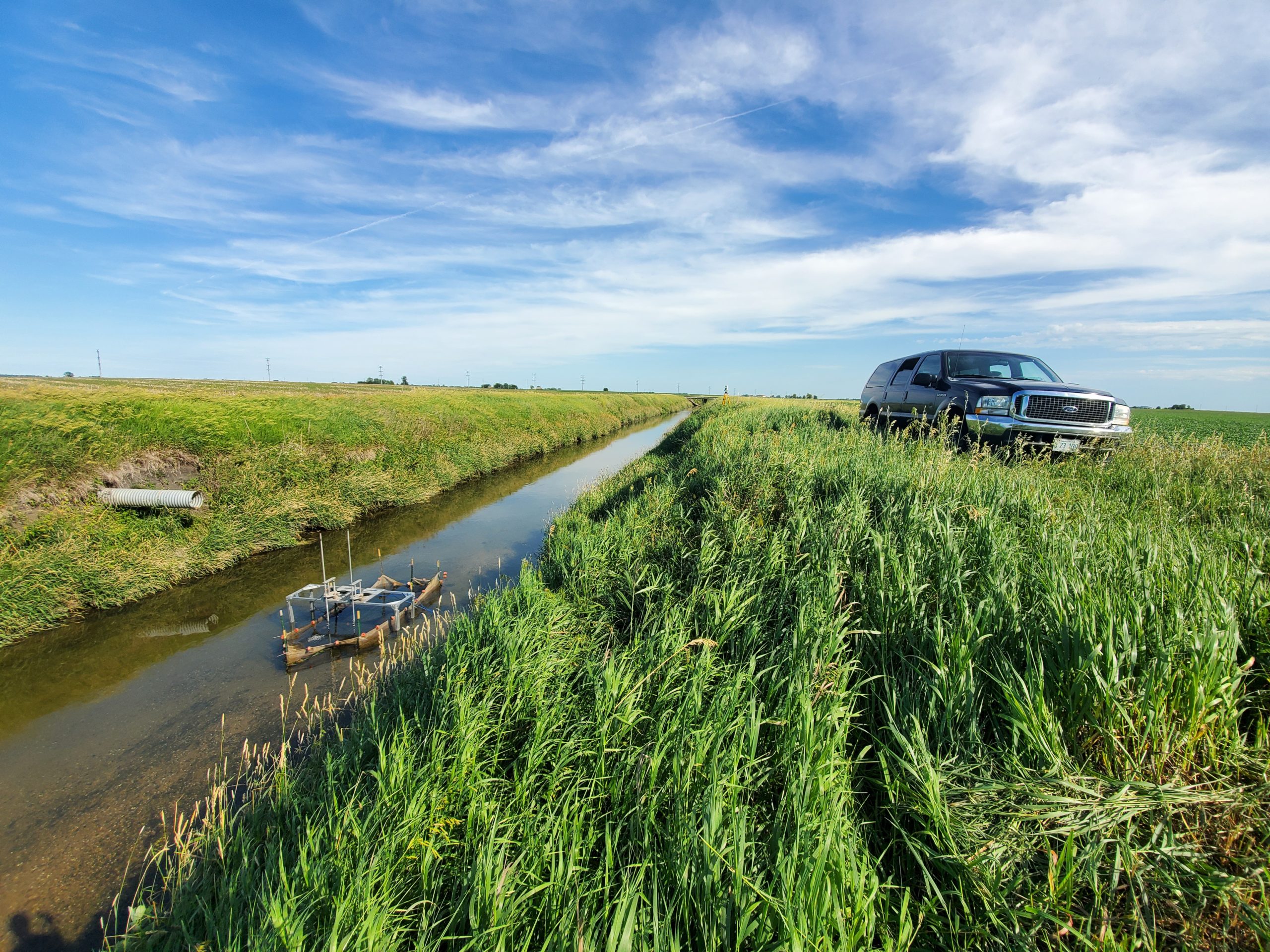
A stream where equipment to measure flow and turbulence has been installed. (Photo courtesy of Katey Strailey)
Q: How can restoration help?
A: Although we can’t always reverse all the damage, we hope that restoration can improve in-stream habitat, increase water quality, and prevent excessive erosion of stream banks. But the jury is still out on how effective current restoration strategies actually are in terms of ecological outcomes. In the U.S. alone, it’s estimated that more than $1 billion is spent on river restoration every year, and so we wanted to explore the how it’s helping question a bit more.
Q: For those of us who don’t know much about stream restoration, what new information will your research contribute to the discipline?
Our research focuses on understanding what makes certain turbulence beneficial or harmful for fish. Turbulence is the swirling, chaotic flow you see when you look at a river. That chaos can make it harder for fish to swim, but some types of turbulence actually help fish. Different structures, as the flowing water moves around them, cause different kinds of turbulence. Since structures are often placed in rivers or streams with a goal of helping fish, we need to be sure that fish actually want to be by them, and that they’re not driven away by them.
One issue with this type of research is that, between limited funding and short funding timelines, it’s really common for people to do a project, monitor it for a year or two, and then move on. But we know that it can take 10-15 years to see the effects a single project has on fish populations. This is where studying fish physiology has an advantage—we can use short-term experiments to understand how restoration actions directly affect individual fish. When you can measure a fish’s oxygen consumption before and after placing an object in the water, and immediately calculate the difference, it’s easier to establish that causal link. It can also hint at how fish might be affected over the long term. So, with the information we generate, we want to develop a tool that can help scientists and practitioners create restoration plans that will most benefit the fish in streams that are being restored.
Q: What types of structures do you use to test fish?
Structures in a stream, whether they be natural or designed and placed by people, are often fairly complex. But for the purposes of our experiments, we break them down to basic components. An example is what we refer to as “large woody debris”, which can be logs, branches, and root wads tangled up together. To test how they might affect fish, we can break them down to the characteristics of their components: how big might a branch be? What is its diameter? How is it oriented in the flow?
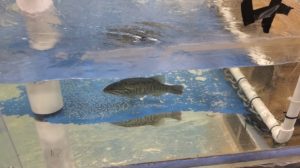
A smallmouth bass is held in a tank during experiments to understand how turbulence around structures affects fish. (Photo courtesy of Katey Strailey)
In my work, I place cylinders that vary by diameter and orientation into tanks to explore how the basic components of structures change the flow. This allows me to very finely link fish responses and flow characteristics to the cylinder and orientation I’m using. For example, lunkers are popular hiding spots for many fish; they look like small wooden caves in the riverbank. Because the overhead components do not affect the flow, we can simulate these structures in our lab experiments using vertical cylinders, then assess their unique turbulence. We can also assess structures found in other natural habitats, such as riffles, that are often incorporated into restoration projects.
Q: What are the mechanics of your experiment?
I honestly think I get to do really cool stuff! Essentially what we’re doing is measuring the decline of oxygen in water as fish do their thing (swim). How much oxygen a fish uses as it swims is linked with how much energy it’s using. By measuring the oxygen they use, we also know how hard they’re working and how much energy they’re using to swim. The catch with oxygen consumption is that with fish, it has to be measured in a completely closed environment with a limited amount of water. If you have too much water, open to the environment, you can’t really know how much of that oxygen is being used by the fish specifically. I use what’s essentially a fish treadmill to measure the oxygen they use: it looks like a little racetrack, the fish hangs out in one section of this racetrack, and the flow recirculates so they can keep swimming while staying in place.
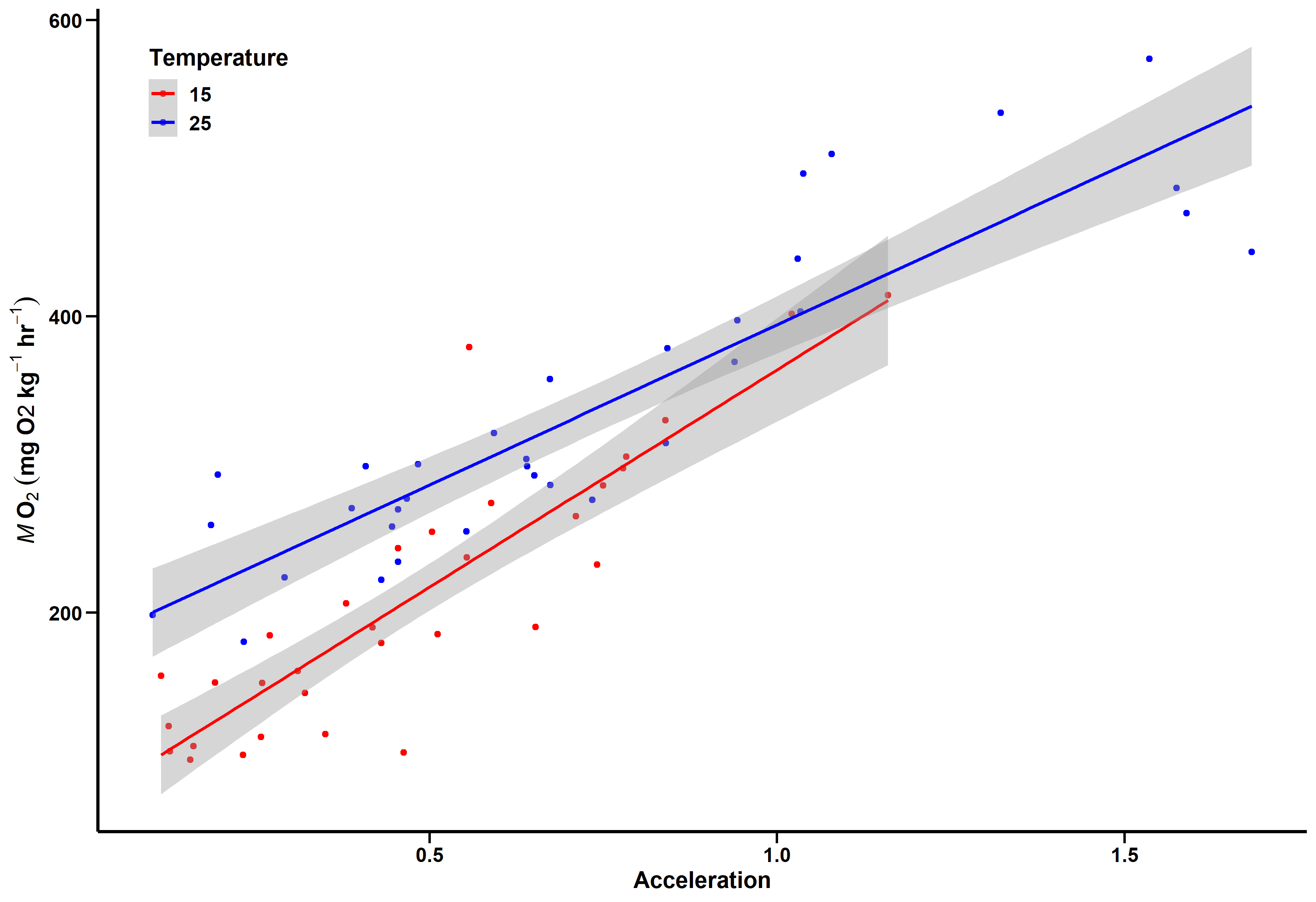
Katey Strailey uses graphs like this to understand how a fish’s oxygen use and their acceleration are related. (Graphic courtesy of Katey Strailey)
Since I can only directly measure this in the fish treadmill, if I want to test them in other environments I have to use a proxy. For my research, that proxy is acceleration. While they’re swimming in the treadmill and I’m measuring the oxygen use, I also measure their acceleration using an accelerometer. This same type of technology is used in smartphones to tell if you’re holding the phone upright or on its side.
Q: How exactly do you use an accelerometer with the fish?
A: I do fish surgeries! I just take these tiny accelerometers and slip them into the fish and let them recover. My fish are very resilient and recover quickly – within minutes, they’re back swimming with their fish buddies. I’ve done well over 100 surgeries and I’ve never lost a fish, ever. When the accelerometer is in a fish and can communicate with a receiver I have, I can put the fish in any kind of environment and then estimate how much energy they’re using to swim, thanks to the link to the fish treadmill that we already talked about.

A rainbow trout is held in a tank while oxygen and acceleration are measured. (Photo courtesy of Katey Strailey)
Q: What gets you most excited about this project?
A: We aren’t just sticking with the lab! We are moving towards real world and real river environments. Other studies have looked at the interactions between fish and turbulence, but it oftentimes comes from an interesting novelty angle. There’s not much research that applies this to a conservation or restoration context. Our ultimate goal here is to find new tools, or something that can complement other methods, to help refine best practices during restoration efforts.
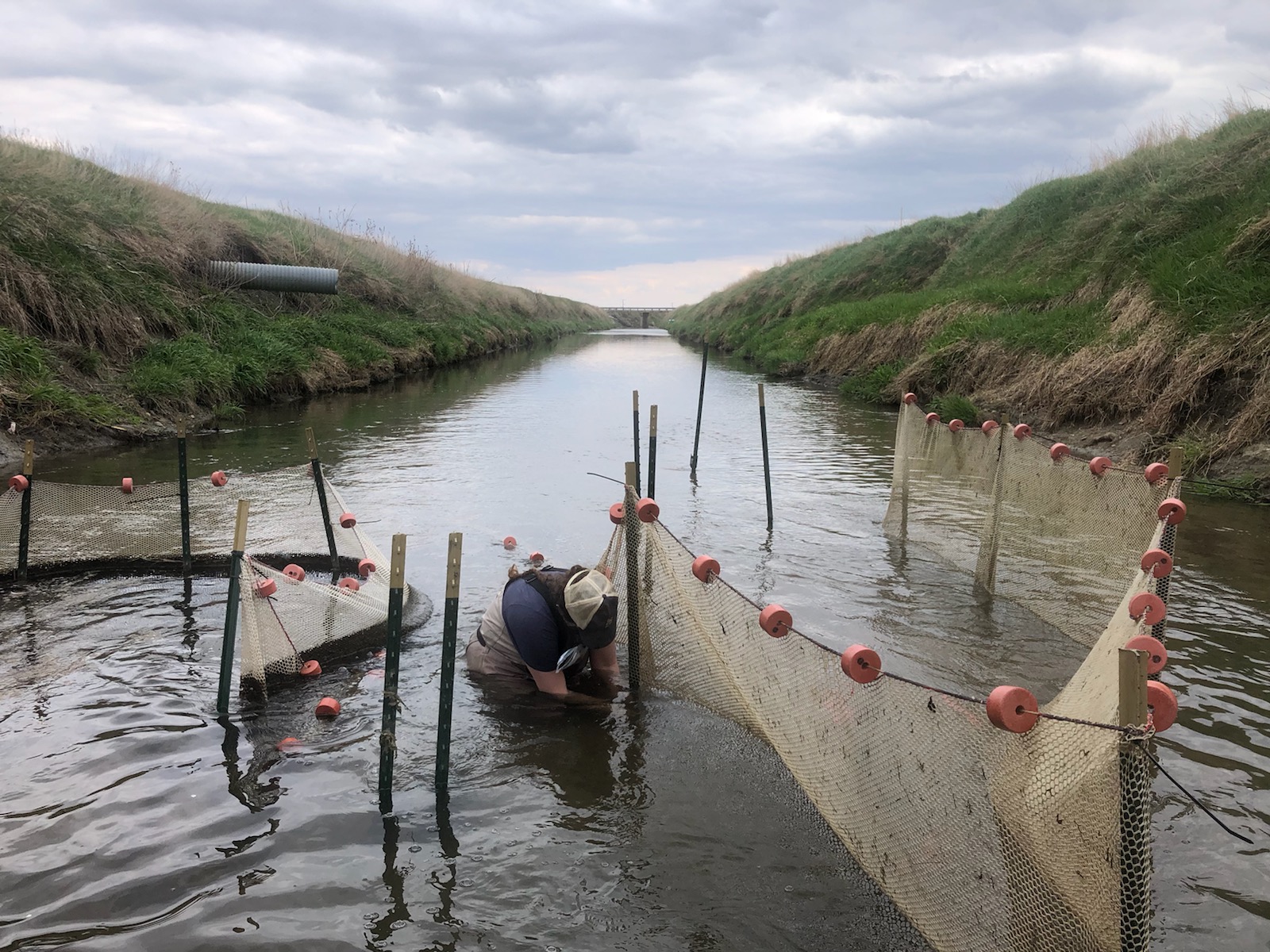
Researchers repair field enclosures. These help understand effects of river and stream restoration on fish. (Photo courtesy of Katey Strailey)
Q: What species do you use?
A: I’ve used two species: rainbow trout and smallmouth bass. The rainbow trout are the ideal species for any study looking at fish and turbulence because of their body shape, which is sort of narrow like salmon and other fish that are raised in hatcheries and then released into streams that feed Lake Michigan.
Another thing I am excited about is that when I was doing my large-scale lab experiments, a lot of my fish would go behind an object oriented vertically in the water. The fish position their bodies so that when a vortex of turbulence comes towards them, their body takes advantage of it and propels them forward into the turbulence. Some fish have this great body shape that can swim upstream without exerting energy. It looked like the smallmouth bass may have done that, but I need to do more trials.
Strailey’s research is a highly collaborative effort across the University of Illinois that includes Cory Suski from Natural Resources and Environmental Sciences, Piotr Cienciala and Bruce Rhoads from Geography and Geographic Information Systems, and Rafael Tinoco from Civil and Environmental Engineering. You can learn more about the exciting research that Katey is conducting by following @_FishFizz, @Piotr_Cienciala, and @rafaelotinoco on Twitter, or by exploring this entry in the IISG Research Project Database: https://iiseagrant.org/research-project/investigating-fish-energy-use-and-swimming-behavior-in-turbulent-flows-guiding-restoration-of-lake-michigan-tributaries/. This abbreviated transcript was edited for length and clarity.
Illinois-Indiana Sea Grant is a part of University of Illinois Extension and Purdue Extension.
Contacts:
Katey Strailey, ks26@illinois.edu
Carolyn Foley

